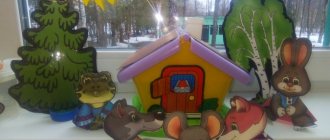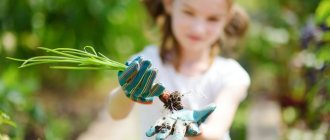Indoor plants play a special role in children's institutions: they are not only decoration, but also an effective means of raising and educating children. If you organize work with indoor plants correctly, it will undoubtedly expand children’s understanding of living nature, develop their powers of observation and aesthetic perception of the world, and help instill skills in growing and caring for plants. The hygienic role of plants is also important, since children, unfortunately, spend a lot of time indoors.
In all kindergartens, group rooms now have corners of wildlife filled with a wide variety of plants. Recently, the range of exotic and ordinary indoor plants in flower shops has significantly expanded, and bookstores offer us a huge number of recommendations on their use.
But how to use indoor plants in the upbringing and education of preschool children, what plants can and should be used in corners of nature?
When selecting indoor plants for your corner of nature (in any age group), you should take into account a number of basic requirements in order to avoid mistakes and ensure efficiency in future work:
- first of all, you should pay attention not to the number of plants, but to the fact that indoor plants are outwardly bright, well-groomed, attractive, and capable of holding the not-yet-steady attention of children.
- it is necessary to have several copies of the same plant, which would provide the opportunity to see not only similarities, but also to note the individual characteristics of plants
- indoor plants must be absolutely safe for children; plants that are poisonous, prickly or emit a strong aroma should not be used.
- the place where indoor plants are located should be accessible to children for work and observation, so it is necessary to select those that are the most unpretentious and do not require special conditions of care and maintenance.
- if you use more demanding plants for classes, observations and work, then it is necessary to create all the conditions for their normal growth and development (i.e. temperature, humidity, light, etc.)
Of course, there are some peculiarities in organizing a corner of nature and selecting indoor plants for older and younger age groups.
1. HOUSE PLANTS OF YOUNGER GROUPS.
When selecting indoor plants in a corner of nature for the younger groups of a kindergarten, you should take into account the peculiarities of children’s perception of objects (kids, first of all, pay attention to the brightest and most beautiful of them). Children develop the ability to recognize a plant, distinguish and name its individual parts. Pupils in the younger group must learn to recognize and name 2-3 plants and their parts (stem, leaf, flower).
In the corner of nature of the younger groups, plants are placed that have clearly defined main parts (stem, leaf) and bloom beautifully and abundantly. This could be ordinary geranium, fuchsia, ever-flowering begonia, balsam, Chinese raza, etc. Children will also be interested in plants with variegated leaves (aucuba, coleus). They also have distinct stems and leaves that can be used to teach children the first simple techniques for keeping plants clean. From the named plant species, 3-4 specimens should be selected. In this case, you need to have two identical plants in the corner so that children have the opportunity to find them and compare them with others.
2. HOUSE PLANTS IN THE MIDDLE GROUP.
In the middle group, it is necessary to develop in children the ability to see the various properties and qualities of plants and their parts: the variety of shapes, colors, size of the leaf plate, the nature of the surface, etc. Children 4-5 years old can master more complex comparison techniques, learn to make differences and similarities between different plants, generalize them according to certain characteristics.
Knowledge about plants is also becoming more complex. Children more clearly distinguish the characteristics of plants and become familiar with the conditions necessary for their life. The number of plants they recognize and name increases. In the process of caring (together with the teacher), children acquire simple skills: keeping plants clean, proper watering, etc.
The nature corner in the middle group needs to be replenished with new plants. First of all, you should select indoor plants that have different shapes and leaf sizes. Children can learn new techniques for keeping plants clean: using a fine-mesh watering can or spraying plants with small leaves, wiping jagged leaves with a damp brush or brush, pubescent leaves with a dry brush, etc. At the same time, children learn to determine the dependence of the method plant care on the nature of the leaves: their size, quantity, surface, fragility. Children do all work with indoor plants together with the teacher and under his guidance.
In addition to the plants for the nature corner of the younger groups, in the middle group they also place aloe or agave (with fleshy leaves with jagged edges), rex begonia, asparagus, fragrant geranium (with patterned pubescent leaves), etc. At the same time, in the nature corner there can be up to 6-8 different plants. It should be especially noted that in the middle group it is good to have different types of plants of the same family, for example: zonal and fragrant geraniums, several types of begonias, white-flowering and zebra-shaped Tradescantia, etc. This will teach children to find similarities and differences in these plants.
3. HOUSE PLANTS OF THE SENIOR GROUP.
In the older group, the formation of skills to observe plants, compare, generalize and classify them according to various characteristics continues. The main content of observations is the growth and development of plants, their changes over the seasons.
The knowledge of older children about plants receives significant additions. Children will learn that a plant needs light, moisture, warmth, and soil nutrition to grow. If something is missing, it can lead to the death of the plant. Children should be explained that different plants need different amounts of light and moisture: some grow well in bright light, others in the shade; some need frequent watering, others need to be watered rarely.
Children continue to get acquainted with many plants, with the features of their external structure, with the variety of leaves, stems, and flowers. The ability to determine how to care for a plant depending on the nature of the leaves and stem is consolidated. The content of knowledge about plants includes ideas about some methods of vegetative propagation of indoor plants (propagation by stem cuttings).
All these tasks require the introduction of an additional number of plants into the corner (in this case, some of the plants are removed or transferred to the younger or middle group).
Plants with a variety of stems (climbing, creeping), having bulbs and rhizomes are introduced. These can be 2-3 types of tradescantia, indoor grapes (cissus), climbing ivy (scindapsus), cyclamen, primrose, amaryllis, clivia, etc. They have leaves, stems, and flowers of various shapes and characters; they have different needs in terms of light levels and watering.
4. HOUSE PLANTS FOR PREPARATORY GROUP.
The main task of introducing children to nature in the preparatory group is to develop in them basic knowledge about significant dependencies in the natural world. And if we talk about indoor plants, this is the dependence of the life of indoor plants on the presence of a set of conditions: moisture, heat, light. It is also important to draw children’s attention to the dependence of the structure and appearance of plants on their living conditions, because they are all aliens from different parts of our planet. It is enough to place a geographical map in a corner of nature and mark with icons the places of origin, the homeland of certain plants. By traveling with plants around the world map, we can awaken children's desire to learn more about other countries and continents, about what animals live there, what kind of people live there. So indoor plants will help you acquire basic knowledge of geography.
Children will also become familiar with the constantly recurring natural changes in the life of plants in different seasons, with the main stages of their growth and development.
Acquaintance with vegetative propagation of plants will continue. The methods of care and the very nature of the organization of work are becoming more complex (duties in a corner of nature are being introduced). The children learn to determine both the method of care and its necessity.
Children should be able to see the essential signs and individual characteristics of various plants, their variability.
In accordance with these tasks, special attention should be paid to the diversity of plants not only in their external structure, but also in their needs in certain environmental conditions.
System for introducing preschool children to indoor plants
The system for introducing preschool children to indoor plants consists of the interaction of three main blocks:
1) classes as a specially organized form of training;
2) joint activities of the teacher and children;
3) independent activity of children.
In the first block, the teaching function belongs to the teacher, the second block assumes the position of an equal partnership between an adult and a child, and in the third block, children are given the opportunity to act independently, using accumulated knowledge and experience.
1ST BLOCK: SPECIALLY ORGANIZED TRAINING
This should include classes and excursions.
The classes include:
- observations of indoor plants (this can be recognition, comparative, observations of plant growth and development)
-visual activities (especially in older groups)
- training in caring for certain types of indoor plants
-this can also be classes on speech development (for example: composing descriptive stories, riddles, inventing fairy tales, ethical conversations, etc.)
-classes on generalizing ideas and classification using models or in the form of specially organized didactic games.
In the absence of a winter or botanical garden of exotic plants, it seems impossible to organize full-fledged excursions, but you should not immediately abandon training in this form. It is enough to organize an excursion to a neighboring group: examine the plants that you do not have, note their condition, and provide useful and educational information about them. As a gift, you can offer cuttings of plants grown by the children themselves, especially if such an excursion is conducted for older children in the younger group.
2ND BLOCK: JOINT ACTIVITY OF TEACHERS WITH CHILDREN
- these are observations in a corner of nature
- didactic games
-stories from the teacher or reading fiction
- conversations with children
-examination of illustrations in books (a huge number of illustrated reference books and encyclopedias of indoor plants are now being published)
-simple experiments
-viewings of films and videos
-working with models
-various types of visual activities.
3RD BLOCK: CHILDREN'S INDEPENDENT ACTIVITY.
In older groups, with sufficient experience, skills and abilities, children can independently carry out the instructions of the teacher for simple plant care.
This is, first of all, watering the plants, wiping plants with dense leathery leaves with a damp cloth, sweeping away dust, and washing pallets. It should be noted that a feature of this type of activity is that the teacher first discusses with the children the work plan and the sequence of actions to be performed, and then the instructions are carried out independently, but with constant supervision from the teacher.
-It can also be an independent visual activity.
-examination of illustrated albums and books.
ORGANIZATION OF CLASSES AND JOINT ACTIVITIES FOR FAMILIARIZATION WITH HOUSEPLANTS IN JUNIOR
When organizing classes to familiarize younger preschoolers with indoor plants, the teacher solves three main tasks:
1) consistently and systematically form children’s knowledge about indoor plants, new work skills and abilities;
2) using the cognitive content of classes - to promote the development of speech skills (activation of vocabulary, clarity of speech, grammatically correct speech, etc.)
3) formation of a positive attitude towards living nature and plants in particular.
If we talk about the methodology of conducting classes in younger groups, then preference should be given to visual and practical methods, namely: observations, examination of visual and illustrative material, didactic games). Verbal methods are used constantly, but as additional ones.
It should be noted that in the younger groups
the same topic of the lesson should be repeated many times in order to consolidate and strengthen knowledge and cognitive skills.
Specially organized didactic games can play a special role in this. What knowledge should be acquired by children of younger groups during such games?
1.Names of 1-2 indoor plants
2.Structure of indoor plants (“Like a tree, like grass”)
3.Know and show parts of a plant: flower (one or many); branch; leaf (large, small, green)
In order for kids to better assimilate this knowledge, you should first be given the task of finding plants by similarity (“Find the same one”), while children see that indoor plants are different from each other (for example: two are the same, and the third is not similar). Then you should draw the children’s attention to how these plants differ from each other (leaf shape, size, flower color, etc.) After this, you can play a game like “Find by description.” During such games, you should not demand children's knowledge of plant names.
Children of younger age groups receive basic knowledge about indoor plants not in classes, but in everyday life and in joint activities. Therefore, this work should be carried out purposefully, help children gradually accumulate knowledge, maintain their curiosity and activity, constantly encourage them to make observations (for example: pay attention to how the leaves of a plant on the window turned towards the light, or how beautiful a flower bloomed, etc. .)
Throughout the year, in everyday life, the teacher must work to develop basic work skills. But even such a simple, at first glance, work as watering indoor plants requires special attention and control from the teacher. So, at first, children can only watch the teacher’s work and listen to his explanations, and then passively participate in watering: in this case, the child holds a watering can with water, and the teacher guides the child’s hand with his own hand.
So, gradually, as a result of observations and work in a corner of nature, children develop specific information about the appearance of indoor plants and some ways to care for them.
ORGANIZATION OF CLASSES, JOINT AND INDEPENDENT ACTIVITIES FOR SECONDARY GROUP CHILDREN IN FAMILIARIZING WITH HOUSE PLANTS.
In the middle group, a significant place is occupied by classes aimed at primary familiarization with indoor plants, which involve the formation of specific knowledge about them.
It is most advisable to use observational classes for this purpose. From the middle group you can also conduct such a special type of lesson as an excursion. For children in the middle group, classes are conducted with the goal of expanding, deepening, and consolidating children’s knowledge about indoor plants, as well as classes to teach basic ways to care for them. Mastering initial knowledge about the needs of various plants, as well as the conditions necessary to satisfy these needs, makes it possible to teach children how to properly water indoor plants in an organized manner and show some simple ways to remove dust from leaves. Such activities help consolidate and clarify previously acquired knowledge, as well as actively apply it in practical activities and teach children to care about living nature.
When organizing classes in the middle group, one should take into account the increased fragmentation (division) of perception, i.e. the ability to name a large number of signs, but not the ability to single out the most significant, main ones, and children should be taught this. Both in everyday life and in the classroom it is necessary to use various didactic games
. Children in the middle group already have some ideas about indoor plants, so in such games you can introduce more complex tasks, for example: find plants according to the teacher’s description, and then repeat tasks that help the children describe the plants themselves. Thus, children's attention will be directed to the distinctive features of individual indoor plants and their structure. When conducting games, the teacher himself pronounces the name of the plants as often as possible. After this, it will be much easier for children to cope with a task such as “Find a plant by name.”




